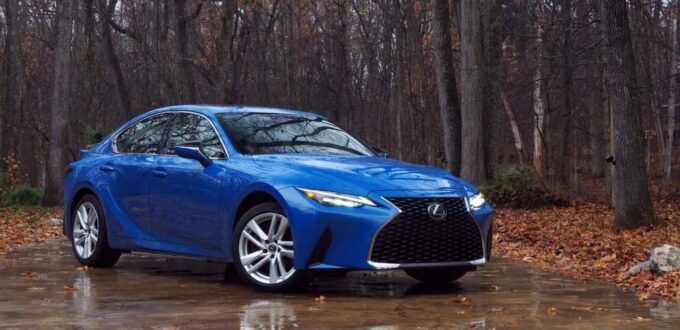In many ways, the 2021 Lexus IS 300 AWD feels like the automotive equivalent of a time capsule. Though refreshed and restyled, the current-generation IS still dates back to 2014; you’d be forgiven for wondering whether Lexus’ most affordable – and second-best-selling – sedan has fallen too far behind.
That gets you a 2.0-liter turbocharged inline-4 that brings 241 horsepower and 258 lb-ft of torque to play, directed via an eight-speed automatic transmission through the rear wheels. My Grecian Water IS 300 AWD review car, meanwhile, has a 3.5-liter V6 with 260 horsepower and 236 lb-ft of torque, and pairs its all-wheel drive with a six-speed automatic.
Confusingly, there’s an IS 350 RWD which has the same V6 – though tuned for 311 hp and 280 lb-ft – and an eight-speed automatic. An IS 500, meanwhile, throws in a V8: it’s a nice reminder that Lexus hasn’t quite given up on big displacement, naturally-aspirated engines yet.
Despite what the figures say on paper, the IS 300 AWD is unexpectedly punchy. No, the six-speed doesn’t feel as fresh and lively as the transmissions in some of Lexus’ rivals, but as long as you’re not seriously pushing things it keeps up just swell. It’s smooth, too, and the tactile metal paddle-shifters mean you can override its somewhat reluctant downshifts when you want to push harder.
While the engines may be old, the chassis and suspension tuning is new. There’s more reinforcement to make it stiffer, while the suspension has gone on a serious diet. Factor in nicely-weighted steering and it leaves the IS 300 AWD feeling unexpectedly fresh and lithe. Flick to Comfort mode, meanwhile, and though there are no trick adjustable dampers it’s still refined and smooth. Lexus clearly paid attention to what really needed it, and that focus has paid off.
You could say the same for the exterior changes. Though the IS wears Lexus’ sizable front grille, it handles the scale of that maw well; better, I’d argue, than some of the automaker’s larger sedans. Design is subjective, but the tasteful creases and judicious (but not lavish) application of chrome pay off. I particularly like the new rear treatment, where the angular lamps, trunk-spanning light bar, and some clever interplay of the deck lid spoiler and concave surfacing underneath leave the IS looking fresh and distinctive.
Inside, most of the cabin is unchanged. The seats are comfortable, the switchgear sturdy, and Lexus’ plastics remain firmly top-notch. On the flip side, there’s an notable absence of storage, and the whole thing feels snug, particularly in the rear where passengers in rival sedans get more legroom. The same goes for the relatively small 10.8 cu-ft trunk. Lexus, of course, couldn’t make any meaningful changes there, but it did address the IS’ most common complaint.
Praise be, the standard 8-inch infotainment screen is now finger-friendly. There’s a touchpad in the center console, but you can reach out and tap the touchscreen instead to interact with Lexus’ Entune system or, even more gratifyingly, Apple CarPlay and Android Auto. They’re wired rather than wireless, but I’ll take what wins I can get.
Enform itself is, well, not the greatest system out there. Lexus clearly knows that, as it has already developed a replacement, though it’s unclear when that might percolate through the range. The $2,750 Mark Levinson audio package gives the speakers a 1,800W upgrade and sounds great, as well as throwing in navigation on a larger, 10.3-inch touchscreen.


No Comments Yet